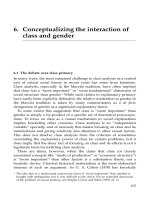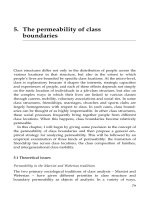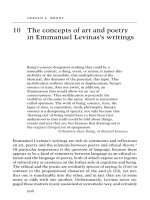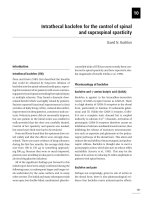Conceptualizing the interaction of class and gender
Bạn đang xem bản rút gọn của tài liệu. Xem và tải ngay bản đầy đủ của tài liệu tại đây (56.68 KB, 10 trang )
6. Conceptualizing the interaction of
class and gender
6.1 The debate over class primacy
In many ways, the most sustained challenge to class analysis as a central
axis of critical social theory in recent years has come from feminists.
Class analysts, especially in the Marxist tradition, have often implied
that class was a ``more important'' or ``more fundamental'' dimension of
social structure than gender.
1
While such claims to explanatory primacy
have rarely been explicitly defended, the relative inattention to gender in
the Marxist tradition is taken by many commentators as a de facto
denigration of gender as a signi®cant explanatory factor.
To some extent this suggestion that class is ``more important'' than
gender is simply a by-product of a speci®c set of theoretical preoccupa-
tions. To focus on class as a causal mechanism in social explanations
implies bracketing other concerns. Class analysis is an ``independent
variable'' specialty, and of necessity this means focusing on class and its
rami®cations and giving relatively less attention to other causal factors.
This does not absolve class analysts from the criticism of sometimes
overstating the explanatory power of class for certain problems, but it
does imply that the sheer fact of focusing on class and its effects is not a
legitimate basis for indicting class analysis.
There are times, however, when the claim that class (or closely
associated concepts like ``mode of production'' or ``economic structure'')
is ``more important'' than other factors is a substantive thesis, not a
heuristic device. Classical historical materialism is the most elaborated
instance of such an argument. As G. A. Cohen (1978) has forcefully
1
The idea that in a multicausal system one factor is ``more important'' than another is
fraught with ambiguities and is very dif®cult to pin down. For an extended discussion
of the problem of causal primacy, see Wright, Levine and Sober (1992: ch. 7).
115
demonstrated, the part of historical materialism that is built around the
base/superstructure metaphor ascribes explanatory primacy to class
through the use of functional explanations: the base (the economic
structure conceptualized in class terms) ``functionally explains'' the
superstructure. What does this mean? It means that superstructural
phenomena take the form that they do because this form helps to
reproduce the existing economic structure. This is quite akin to func-
tional explanations in biology where a given trait of an animal is
functionally explained by its effects in helping the animal survive and
reproduce. Why are the bones in the wings of birds hollow? Because this
helps them to ¯y. The bene®cial effect of hollowness (lighter wings
facilitate ¯ight) explains the fact of hollowness. In the social case, the
functional explanation embodied in historical materialism means that
various social institutions ± certain features of the state, certain aspects of
ideology, certain kinds of laws and so forth ± are explained by the fact
that they generate effects which help reproduce the economic structure.
2
Since the economic structure is itself composed of social relations of
production which collectively de®ne the class structure, this is a form of
class primacy.
At ®rst glance it might seem like classical historical materialism makes
extraordinarily strong and encompassing claims about the centrality of
class. But as G. A. Cohen (1988: ch. 9) has also argued, even classical
historical materialism does not make the grandiose claim that class is the
most important cause of everything social. Historical materialism is not a
theory of all social phenomena, but only of a speci®c set of explananda ±
the historical trajectory of economic structures and their accompanying
superstructures.
3
The superstructure, in these terms, is not de®ned as all
social relations and institutions that are not part of the economic base.
2
It is important to note that in this kind of functional explanation there is no suggestion
that the superstructure is ``epiphenomenal'' ± a mere re¯ection of the base that has no
consequences in its own right. To say that X functionally explains Y implies that Y has
signi®cant effects on X. If it is true that the class structure of capitalism functionally
explains the form of the state, then this implies that the state must have signi®cant
consequences for reproducing the class structure. If the state had no consequences there
would be no point to a functional explanation.
3
There are Marxists, particularly those working within a strongly Hegelian tradition,
who insist that Marxist concepts and theory do attempt to explain everything. Shelton
and Agger (1993: 36), for example, write, ``Marxism is not simply a theory of class but a
theory of everything, including women.'' While I do not think that the aspiration for
such a totalizing theoretical project should be rejected a priori, in practice Marxism has
not been successful in accomplishing this ambition, and the prospects for doing so are
not very promising.
Class counts116
Rather, the superstructure is limited to those noneconomic social phe-
nomena which have effects on the reproduction of the base; these are the
phenomena which are candidates for functional explanations of the sort
historical materialism defends. What Cohen aptly calls ``restrictive
historical materialism'' is agnostic about the relative explanatory impor-
tance of class for various phenomena which are not part of the economic
structure or the superstructure, and this would potentially include
many cultural phenomena and possibly signi®cant aspects of gender
relations.
4
This kind of functionalist reasoning in historical materialism has
played an important role in Marxist analyses of gender relations. Engels'
(1968 [1884]) famous discussion of the origins of male domination, for
example, explains the subordination of women in terms of its effects on
stabilizing the inheritance of private property. This is an explanation of
gender relations in terms of the functional requirements of maintaining a
system of private property. In more recent discussions, the functional
explanations have shifted to the bene®cial effects of gender oppression
for capital accumulation.
5
For example, a number of contributors to the
``domestic labor debate'' of the 1970s (e.g. Secombe 1974; Gardiner 1975)
argued that the subordination of women is rooted in the sexual division
of labor in the household, and this in turn is to be explained by the fact
that the unpaid domestic labor of women raises the rate of pro®t by
lowering the costs of reproducing labor power (since part of the
consumption of workers takes the form of unpaid services of house-
wives). Others (e.g. Zaretsky 1976) have argued that the central basis for
women's oppression in capitalism lies in the ways the gender division of
labor helps to reproduce capitalism ideologically by strengthening a
4
The contrast to ``restrictive'' historical materialism is ``inclusive'' historical materialism,
in which the superstructure is de®ned as everything that is not in the base. Cohen
shows that inclusive historical materialism is wildly implausible. Probably no one who
really thought systematically about the issues seriously ever really held it.
5
These arguments do not necessarily use the explicit language of functional explanation.
Thus, for example, Gardiner (1975: 52) discusses domestic labor in terms of the
``essential although changing role'' it plays. She asks the question, ``Why has domestic
labour been maintained?'' and answers it by saying: ``capitalism developed out of
feudalism through workers becoming dependent on the wage system, but has never
provided totally for workers' needs through commodity production, instead retaining
domestic labor to carry out an important part of the reproduction and maintenance of
labor power.'' The suggestion here is that the explanation for the maintenance of unpaid
domestic labor (and the gender relations associated with this labor) is the role played by
this labor for capitalism. The word ``role'' in this context implies a functional
explanation.
117Interaction of class and gender
privatized, consumption-centered vision of family life. In all of these
instances, class is accorded explanatory primacy through the use of
functional explanations.
Relatively few class analysts, even those still explicitly identifying
with the Marxist tradition, strictly adhere to the tenets of classical
historical materialism any longer. Virtually no one defends strong
functionalist versions of the base/superstructure image of society, even
for the speci®c task of explaining historical trajectories of economic
structures. Marxist class analysis is now generally closer to what might
be loosely termed ``sociological materialism'' in which class, because of
its linkage to exploitation and the control of economic resources, has a
presumptive importance for a broad range of social problems, but is not
invariably viewed as the most important determinant. While it remains
the case that Marxists generally do try to place class analysis in an
historical context, this usually has at best a tenuous relation to a
materialist theory of the overall trajectory of human history as such. In
practice, then, to be ``historical'' has generally come to mean ``to be
historically speci®c,'' rather than ``to be embedded in a theory of
history.''
6
As a result, the debate over what was once called ``class
reductionism'' or ``economic determinism'' has waned considerably in
recent years.
If one accepts this way of understanding the explanatory project of
class analysis, then the central task is to sort out for speci®c explananda
the forms of interaction between class and gender as causal processes.
Class may indeed turn out to be ``more important'' than gender for
certain problems, but equally, gender may be more important than class
for others. Advances in the class analysis of gender and the gender
analysis of class depend upon research that will clarify these interac-
tions.
6.2 Forms of interconnection of class and gender
As a preliminary task to empirical investigations of class and gender, it is
useful to lay out a conceptual menu of the various ways that class and
gender might be interconnected. This list is not meant to be exhaustive,
and it certainly does not constitute a theory of class and gender. Rather, it
is an agenda of issues that need to be considered within empirical
6
For a discussion of the slide from historical materialism towards sociological
materialism, see Wright, Levine and Sober (1992: ch. 5).
Class counts118
research and theory construction. Five forms of possible class/gender
interconnections are particularly important: gender as a form of class
relations; gender relations and class relations as reciprocally affecting each
other; gender as a sorting mechanism into class locations; gender as a
mediated linkage to class locations; and gender as a causal interaction with
class in determining various outcomes. Let us brie¯y look at each of these.
1 Gender as a form of class relations
While the concepts of class and gender are analytically distinct, there are
empirical situations in which gender relations themselves are a form of
class relation (or, equivalently, that class relations are themselves directly
organized through gender relations). Frederick Engels (1968 [1884]: 503),
in his classic essay on the family and private property, formulates the
relationship between class and gender in early civilizations this way:
``The ®rst class antagonism which appears in history coincides with the
development of the antagonism between man and woman in monoga-
mian marriage, and the ®rst class oppression with the of the female sex
by the male..'' Gerda Lerner (1986) elaborates a rather different argument
about the con¯uence of class and gender in early civilizations. She
argues that one of the earliest forms of male domination consisted of
men effectively owning women, and by virtue of this appropriating the
surplus produced by women. The most important form of this surplus
was new people ± children ± who were a valuable resource in early
agrarian civilizations. Control over the capacity of women to produce
new labor power was thus a pivotal form of property relations. If this
account is correct, then this would constitute a speci®c form of gendered
slavery in which gender and class are melded into a single relation.
7
2 Gender relations and class relations as reciprocally affecting each other
Certain kinds of class positions may only exist by virtue of the fact that
speci®c forms of gender relations are present. The classic example is
domestic services: gender relations play a crucial role in making possible
maid and childcare services (Glenn 1992). It is not just that gender sorts
people into these jobs; if gender relations were dramatically more
7
This would only strictly be true if it were the case that all women were slaves, which
does not seem to be the case in the historical examples cited by Gerda Lerner. The
dystopia portrayed by Margaret Atwood (1987) in A Handmaid's Tale comes closer to a
society within which class and gender are fused into a single relation.
119Interaction of class and gender









